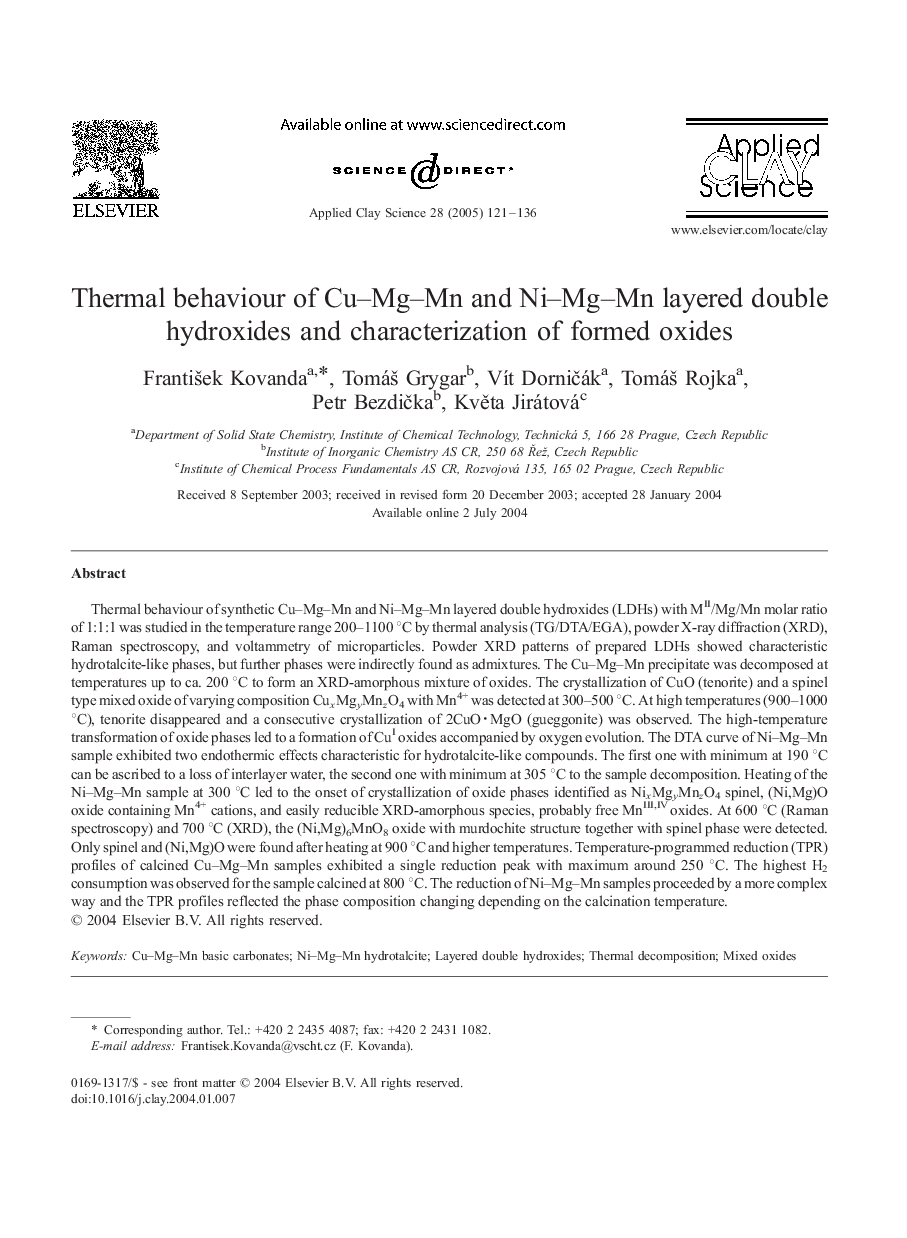| کد مقاله | کد نشریه | سال انتشار | مقاله انگلیسی | نسخه تمام متن |
|---|---|---|---|---|
| 9822542 | 1519146 | 2005 | 16 صفحه PDF | دانلود رایگان |
عنوان انگلیسی مقاله ISI
Thermal behaviour of Cu-Mg-Mn and Ni-Mg-Mn layered double hydroxides and characterization of formed oxides
دانلود مقاله + سفارش ترجمه
دانلود مقاله ISI انگلیسی
رایگان برای ایرانیان
کلمات کلیدی
موضوعات مرتبط
مهندسی و علوم پایه
علوم زمین و سیارات
ژئوشیمی و پترولوژی
پیش نمایش صفحه اول مقاله

چکیده انگلیسی
Thermal behaviour of synthetic Cu-Mg-Mn and Ni-Mg-Mn layered double hydroxides (LDHs) with MII/Mg/Mn molar ratio of 1:1:1 was studied in the temperature range 200-1100 °C by thermal analysis (TG/DTA/EGA), powder X-ray diffraction (XRD), Raman spectroscopy, and voltammetry of microparticles. Powder XRD patterns of prepared LDHs showed characteristic hydrotalcite-like phases, but further phases were indirectly found as admixtures. The Cu-Mg-Mn precipitate was decomposed at temperatures up to ca. 200 °C to form an XRD-amorphous mixture of oxides. The crystallization of CuO (tenorite) and a spinel type mixed oxide of varying composition CuxMgyMnzO4 with Mn4+ was detected at 300-500 °C. At high temperatures (900-1000 °C), tenorite disappeared and a consecutive crystallization of 2CuO·MgO (gueggonite) was observed. The high-temperature transformation of oxide phases led to a formation of CuI oxides accompanied by oxygen evolution. The DTA curve of Ni-Mg-Mn sample exhibited two endothermic effects characteristic for hydrotalcite-like compounds. The first one with minimum at 190 °C can be ascribed to a loss of interlayer water, the second one with minimum at 305 °C to the sample decomposition. Heating of the Ni-Mg-Mn sample at 300 °C led to the onset of crystallization of oxide phases identified as NixMgyMnzO4 spinel, (Ni,Mg)O oxide containing Mn4+ cations, and easily reducible XRD-amorphous species, probably free MnIII,IV oxides. At 600 °C (Raman spectroscopy) and 700 °C (XRD), the (Ni,Mg)6MnO8 oxide with murdochite structure together with spinel phase were detected. Only spinel and (Ni,Mg)O were found after heating at 900 °C and higher temperatures. Temperature-programmed reduction (TPR) profiles of calcined Cu-Mg-Mn samples exhibited a single reduction peak with maximum around 250 °C. The highest H2 consumption was observed for the sample calcined at 800 °C. The reduction of Ni-Mg-Mn samples proceeded by a more complex way and the TPR profiles reflected the phase composition changing depending on the calcination temperature.
ناشر
Database: Elsevier - ScienceDirect (ساینس دایرکت)
Journal: Applied Clay Science - Volume 28, Issues 1â4, January 2005, Pages 121-136
Journal: Applied Clay Science - Volume 28, Issues 1â4, January 2005, Pages 121-136
نویسندگان
FrantiÅ¡ek Kovanda, TomáÅ¡ Grygar, VÃt DorniÄák, TomáÅ¡ Rojka, Petr BezdiÄka, KvÄta Jirátová,